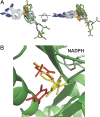In silico activity profiling reveals the mechanism of action of antimalarials discovered in a high-throughput screen
- PMID: 18579783
- PMCID: PMC2440361
- DOI: 10.1073/pnas.0802982105
In silico activity profiling reveals the mechanism of action of antimalarials discovered in a high-throughput screen
Abstract
The growing resistance to current first-line antimalarial drugs represents a major health challenge. To facilitate the discovery of new antimalarials, we have implemented an efficient and robust high-throughput cell-based screen (1,536-well format) based on proliferation of Plasmodium falciparum (Pf) in erythrocytes. From a screen of approximately 1.7 million compounds, we identified a diverse collection of approximately 6,000 small molecules comprised of >530 distinct scaffolds, all of which show potent antimalarial activity (<1.25 microM). Most known antimalarials were identified in this screen, thus validating our approach. In addition, we identified many novel chemical scaffolds, which likely act through both known and novel pathways. We further show that in some cases the mechanism of action of these antimalarials can be determined by in silico compound activity profiling. This method uses large datasets from unrelated cellular and biochemical screens and the guilt-by-association principle to predict which cellular pathway and/or protein target is being inhibited by select compounds. In addition, the screening method has the potential to provide the malaria community with many new starting points for the development of biological probes and drugs with novel antiparasitic activities.
Conflict of interest statement
The authors declare no conflict of interest.
Figures




References
-
- Payne DJ, Gwynn MN, Holmes DJ, Pompliano DL. Drugs for bad bugs: Confronting the challenges of antibacterial discovery. Nat Rev Drug Discovery. 2007;6:29–40. - PubMed
-
- Iber PK, Pavanand K, Wilks NE, Colwell EJ. Evaluation of in vitro drug sensitivity of human Plasmodium falciparum by incorporation of radioactive isoleucine. J Med Assoc Thailand. 1975;58:559–566. - PubMed
Publication types
MeSH terms
Substances
Grants and funding
LinkOut - more resources
Full Text Sources
Other Literature Sources
Molecular Biology Databases

